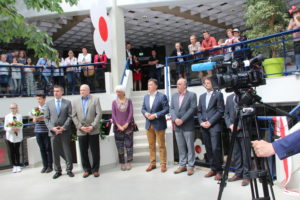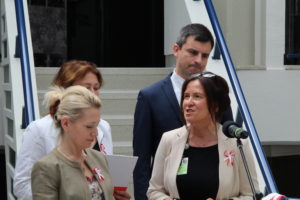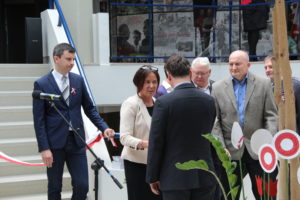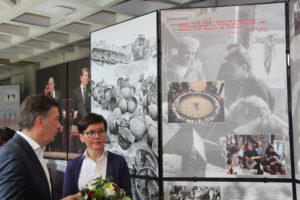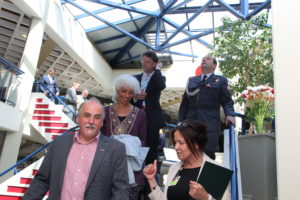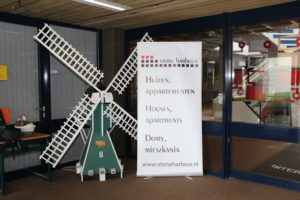On May 13 a fascinating exposition: The Cold War. A concise history of the Divided World was officially opened at a General Stanislaw Sosabowski Polish School located at an Afnorth International School in Brunssum. The consul of the Republic of Poland in the Hague Ms Renata Kowalska, the director of the Afnorth International School Mr Uwe Bettscheider, the director of the Polish School Ms Bozena Cichy and the Senior National Representative at the Allied Joint Force Command Brunssum – Colonel Robert Wierzbinski officially opened the exhibition.
During the opening ceremony Ms Bozena Cichy said that the exhibition shows the world which used to be divided, torn apart and that it is now the past. She added: ‘’ Today, away from Poland, at the international school in the Netherlands, the Poles celebrate their national holiday, and the joy of the celebration is shared with the people who work in their daily lives, contributing to the fact that the events presented on the exhibition boards are a past and history. ‘’ She officially congratulated Beata Bruggeman-Sekowska on being a laureate of a prestigious Polish Public TV award ‘’For the Merits of Poland and Polish people abroad’’ which unifies people all around the world.
The director of Polish School Ms Cichy and the Consul of the Republic of Poland Ms Renata Kowalska thanked the director of the Interational School where Polish school is located for years of support and friendship. They also welcomed and thanked the vice-mayor of Brunssum Mr Frank Joosten for his presence and interest in Polish community.
The exhibition was part of the official celebration of the Polish Constitution of May 3, the first constitution in Europe and the second in the world. During this celebration children attended various workshops concerning the World War II history and Polish national values.
The official celebration was attended by the Polish TV team which will broadcast the repportage about this special event.
About the exhibition
The Cold War exhibition. A concise history of the Divided World is an invitation to a journey back in time, into the reality of the conflict, which dominated the postwar history and influenced lives of millions of people for almost half a century after the end of World War II and which shaped the present-day world.
Contrary to expectations, the end of World War II did not bring hope for an auspicious future, lasting safety, peace and freedom. The war, which began as a clash between Nazi totalitarianism and the world of Western democracies, was won by a coalition of countries, which had irreconcilable regimes and aims. The outcomes of the war proved to be extremely long-lasting, as they shaped the postwar composition of forces for nearly half a century. After victory, a feeling of mistrust and threat between the former allies increased. Exhausted by war, Europe and then the whole world divided into two enemy camps. The vision of a military conflict between them—but this time a nuclear one—seemed more and more probable.The main members of the victorious coalition were de facto at a state of cold war—not a military, but a geopolitical, ideological and economic confrontation.
The Cold War began as a conflict between the Soviet Union on one side and the USA and Western Europe on the other. Then it gradually spread all over the world.The Cold War was a time of polarization of the world determined by the competing superpowers (the USA and the U.S.S.R.), political tensions, ideological rivalry, arms race, intelligence struggle, psychological war, competition for influences in the Third World and confrontation shifted onto peripheral areas. For the first time in history, nobody could be sure to win or to merely survive the cold war. Thus, it could not be decided by means of a military conflict. The Cold War was, however, an actual and at times overly fierce war, even though the superpowers avoided direct military confrontation and eventually did not use their nuclear weapons.
During nearly half a century after its end, the world was a scene of horrifying crimes, with armies and terror apparatuses being used to bloody effects in the whole Central-Eastern Europe, in European colonies, in Asia, Africa and South America—in conflicts which took the lives of millions of people, within and without the Cold War framework. The fall of communism in Central-Eastern Europe (1989−1990), the German Unification (1990) and the dissolution of the U.S.S.R. (1991) occasioned the end of the Cold War. It helped solve some bloody conflicts or bring them under control (e.g. in Nicaragua or Cambodia). Other conflicts, which erupted regardless of the confrontation between the superpowers, but eventually became embroiled in it, went on (or still go on) after its end (e.g. Angola, the Middle East). The West could regard itself a victor of the Cold War but its end did not bring the “end of history,” it merely opened its new chapter.
Text: Communications-Unlimited.nl and the Polish Instutute of National Remembrance.
Photos: Communications-Unlimited.nl
© Copyright www.communications-unlimited.nl, 2017. All rights reserved.
Officials sponsors of this event were:
Stone-Harbour: www.stoneharbour.nl: a real estate company
Pepe TV: a TV company: http://www.pepe-tv.de
Communications-Unlimited: Central and Eastern Europe Center and International Journalism Center:
https://www.facebook.com/journalismlanguagesinternationalization
Read also;
Celebration of the 3rd May: National Polish Holiday, NATO, Brunssum,
For Polish Public TV: exposition about Polish hero in the Netherlands












